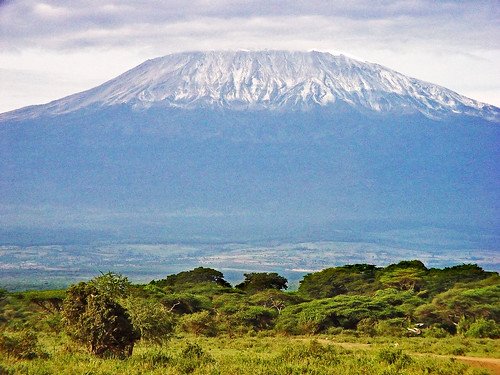
Determinants of diversity in afrotropical herbivorous insects (Lepidoptera: Geometridae): plant diversity, vegetation structure or abiotic factors?
Journal of Biogeography (J. Biogeogr.) (2009) 36: 337–349
Jan C. Axmacher1*, Gunnar Brehm2, Andreas Hemp3, Henry Tu¨nte4, Herbert V. M. Lyaruu5, Klaus Mu¨ller-Hohenstein4 and Konrad Fiedler
1UCL Department of Geography, University College London, London, UK, 2Institut fu¨r Spezielle Zoologie mit Phyletischem Museum, Friedrich-Schiller-Universita¨t Jena, Jena, 3Department of Plant Systematics, Universita¨t Bayreuth, Bayreuth, Germany, 4Department of Biogeography, Universita¨t Bayreuth, Bayreuth, Germany, 5Department of Botany, University of Dar es Salaam, Dar es Salaam, Tanzania and 6Department of Population Ecology, Vienna Ecology Centre, University of Vienna, Vienna, Austria
此研究於非洲第一高峰吉力馬札羅山在海拔1200到3150 m的範圍設置48個樣點400平方公尺的樣區,在各樣區中央針對植食性且具高多樣性的昆蟲類群 - 尺蛾科,以燈光誘集方式進行物種數量與物種更替率調查,並比較其與樣區內維管束植物種類、植被結構(包含樹冠分層、覆蓋度、葉片外形、分枝形式等資料)之關係。結果顯示尺蛾物種的多樣性與樣區內常見植物的科內物種多樣性有關(R2 = 0.49),且與植物結構指數有關(R2 = 0.22),但與整體的植物多樣性無顯著相關。尺蛾的物種更替率與植物科級多樣性之改變範圍有明顯關聯(40% explained variance),與植被外觀的改變關聯較低(25%),與整體的植物多樣性關聯更弱(5%)。然而上述大部分的比較缺乏直接關聯,透過溫度和溼度等環境因子則會同時影響植被與蛾類相,尺蛾科物種多樣性和潛在寄主植物間可能的直接連結顯得更弱。整體植物物種豐富度與尺蛾科多樣性缺乏顯著關聯,暗示熱帶的尺蛾可能對寄主植物並不太有選擇性。因此,植物多樣性與植食者的物種多樣性間的清楚關聯被認為是過於簡化的想法,維管束植物多樣性亦不能被普遍地通用為昆蟲的多樣性指標。
ABSTRACT
Aim This study was conducted to investigate the potential of predicting alpha diversity and turnover rates of a highly diverse herbivorous insect family (Geometridae) based on vascular plant species richness and vegetation structure.
Location The study was carried out on the south-western slopes of Mount Kilimanjaro within a wide range of habitats between 1200 and 3150 m elevation.
Methods The floristic and structural composition of the vegetation was recorded at 48 plots of 400 m2. Geometrid moths were sampled manually at light sources located at the plot centres. Principal components analysis, redundancy analysis and multiple linear regression were used to explore how alpha diversity and species turnover of geometrid moths are related to vegetation structure and plant species richness.
Results Alpha diversity of geometrid moths was significantly correlated with species diversity patterns in the
most common vascular plant families (R2 = 0.49) and with plant structural parameters (R2 = 0.22), but not with overall floristic diversity. Species turnover of geometrid moths was strongly linked to diversity changes in a range of plant families (40% explained variance), less strongly to changes in vegetation physiognomy (25%), and only weakly to overall floristic diversity (5%). Changes in elevation were a better predictor of both alpha diversity and species turnover of geometrid moths than any principal component extracted from the vegetation data.
Main conclusions Vegetation composition, diversity and structure all showed significant correlations with the diversity and species composition of geometrid moth assemblages. Nevertheless, in most cases relationships were indirect, via environmental parameters such as temperature and humidity, which influenced both vegetation and moth fauna. Possible direct links between geometrid diversity and potential food plants were much weaker. The lack of a significant correlation between overall plant species richness and geometrid diversity indicates that tropical geometrid moths may not be very selective in their food plant choice. Accordingly, a clear correlation between floral diversity and herbivore species richness must be regarded as overly simplistic, and the diversity of vascular plants cannot universally be used as a suitable biodiversity indicator for diverse insect taxa at higher trophic levels.
Journal of Biogeography (J. Biogeogr.) (2009) 36: 337–349
Jan C. Axmacher1*, Gunnar Brehm2, Andreas Hemp3, Henry Tu¨nte4, Herbert V. M. Lyaruu5, Klaus Mu¨ller-Hohenstein4 and Konrad Fiedler
1UCL Department of Geography, University College London, London, UK, 2Institut fu¨r Spezielle Zoologie mit Phyletischem Museum, Friedrich-Schiller-Universita¨t Jena, Jena, 3Department of Plant Systematics, Universita¨t Bayreuth, Bayreuth, Germany, 4Department of Biogeography, Universita¨t Bayreuth, Bayreuth, Germany, 5Department of Botany, University of Dar es Salaam, Dar es Salaam, Tanzania and 6Department of Population Ecology, Vienna Ecology Centre, University of Vienna, Vienna, Austria
此研究於非洲第一高峰吉力馬札羅山在海拔1200到3150 m的範圍設置48個樣點400平方公尺的樣區,在各樣區中央針對植食性且具高多樣性的昆蟲類群 - 尺蛾科,以燈光誘集方式進行物種數量與物種更替率調查,並比較其與樣區內維管束植物種類、植被結構(包含樹冠分層、覆蓋度、葉片外形、分枝形式等資料)之關係。結果顯示尺蛾物種的多樣性與樣區內常見植物的科內物種多樣性有關(R2 = 0.49),且與植物結構指數有關(R2 = 0.22),但與整體的植物多樣性無顯著相關。尺蛾的物種更替率與植物科級多樣性之改變範圍有明顯關聯(40% explained variance),與植被外觀的改變關聯較低(25%),與整體的植物多樣性關聯更弱(5%)。然而上述大部分的比較缺乏直接關聯,透過溫度和溼度等環境因子則會同時影響植被與蛾類相,尺蛾科物種多樣性和潛在寄主植物間可能的直接連結顯得更弱。整體植物物種豐富度與尺蛾科多樣性缺乏顯著關聯,暗示熱帶的尺蛾可能對寄主植物並不太有選擇性。因此,植物多樣性與植食者的物種多樣性間的清楚關聯被認為是過於簡化的想法,維管束植物多樣性亦不能被普遍地通用為昆蟲的多樣性指標。
ABSTRACT
Aim This study was conducted to investigate the potential of predicting alpha diversity and turnover rates of a highly diverse herbivorous insect family (Geometridae) based on vascular plant species richness and vegetation structure.
Location The study was carried out on the south-western slopes of Mount Kilimanjaro within a wide range of habitats between 1200 and 3150 m elevation.
Methods The floristic and structural composition of the vegetation was recorded at 48 plots of 400 m2. Geometrid moths were sampled manually at light sources located at the plot centres. Principal components analysis, redundancy analysis and multiple linear regression were used to explore how alpha diversity and species turnover of geometrid moths are related to vegetation structure and plant species richness.
Results Alpha diversity of geometrid moths was significantly correlated with species diversity patterns in the
most common vascular plant families (R2 = 0.49) and with plant structural parameters (R2 = 0.22), but not with overall floristic diversity. Species turnover of geometrid moths was strongly linked to diversity changes in a range of plant families (40% explained variance), less strongly to changes in vegetation physiognomy (25%), and only weakly to overall floristic diversity (5%). Changes in elevation were a better predictor of both alpha diversity and species turnover of geometrid moths than any principal component extracted from the vegetation data.
Main conclusions Vegetation composition, diversity and structure all showed significant correlations with the diversity and species composition of geometrid moth assemblages. Nevertheless, in most cases relationships were indirect, via environmental parameters such as temperature and humidity, which influenced both vegetation and moth fauna. Possible direct links between geometrid diversity and potential food plants were much weaker. The lack of a significant correlation between overall plant species richness and geometrid diversity indicates that tropical geometrid moths may not be very selective in their food plant choice. Accordingly, a clear correlation between floral diversity and herbivore species richness must be regarded as overly simplistic, and the diversity of vascular plants cannot universally be used as a suitable biodiversity indicator for diverse insect taxa at higher trophic levels.

沒有留言:
張貼留言